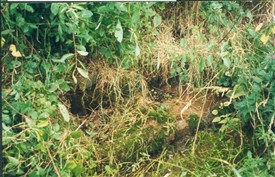The Will Rundle spring

The overgrown trough
East Stoke
By R B Parish
The unusually named Willow Rundle Spring is associated with the nearby Battle of East Stoke in 1487. Antiquarian Cornelius Brown in his History of Newark (1896) notes:
“ In Stoke parish, in the valley between Stoke and Elston, there is a drinking-trough supplied by a spring, in reference to the origin of which the following story has passed current in the village for centuries. A soldier fell in the battle, and a comrade came to his assistance, and gave him water from his bottle. Feeling he was dying, he told his friend that if his soul went to paradise there would arise from the spot where he fell a spring that would flow on forever. The spring now supplies the modern trough, and it is said of it that it has never been known to dry up in the hottest summer, or to be frozen over in the coldest winter.”
So as poor Willie lay dying on the ground the spring water gushed out. Another story says that he fell to his knees on at the site and prayed for water and so the spring arose. This is a common folk motif and can be seen in many counties.
An alternative origin of the name is given by Rosemary Robb in her Ghosts and Legends of Newark (1989) that the soldier was called Willie Rundle escaping the slaughter of East Stoke was ambushed here and thrown from his horse, and a spring arose where he landed. Another theory, I was told locally is that the name derives from the fact that willow stakes were used topiece the heart of the rebels and they were buried by the spring.
Whatever the true it is more likely that the name derives from the presence of willows at this watery site and the word Rundle probably derives from Runnel a word for stream.
The spring has a copious flow; it never dried in the drought of 1976, but is often quite overgrown. Although not marked on the O/S map it is easily found and fills a damaged three foot long rectangular stone trough which overflows through a gap into the ditch. The water is said to be sweet and famed for medicinal properties. There is an old chapel at Elston which some authorities believe was a leper hospital and as such this site may have been associated with that.
Extracted from R.B. Parish, Holy wells and healing springs of Nottinghamshire